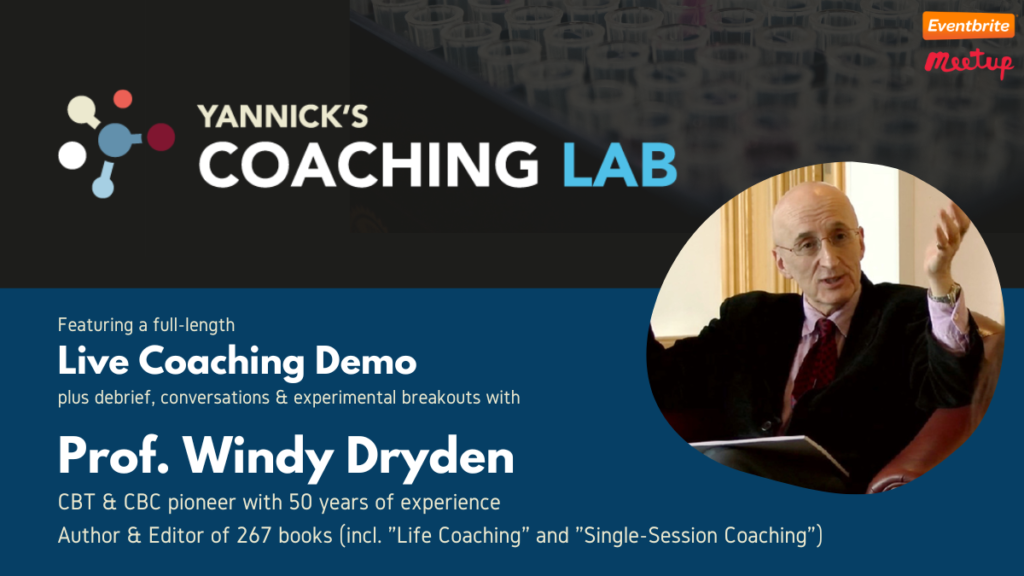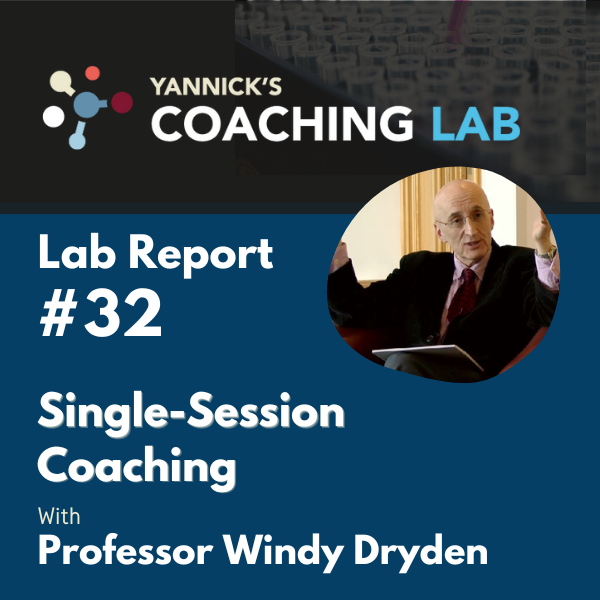
Curious to know what this session was like? Have a peek at the Lab Report below or consider VIP membership to access the full recording of this and many more exciting sessions.
Yannick’s Coaching Lab #32 — Prof Windy Dryden
Lab Report by Daniel Lev Shkolnik
Summary
Windy Dryden, Emeritus Professor of Psychotherapeutic Studies at Goldsmiths University of London, is a therapist and coach with over 50 years experience. He’s one of the leading practitioners and trainers for Cognitive Behaviour Therapy (CBT) and Single-Session Therapy (SST). WIndy has published over 240 books and trained therapists all over the world. In this Lab, Windy demonstrated a Single Session approach to Coaching (SSC) with a client who wanted to stop procrastinating. The discussion that followed explored advantages and possible limitations of a Single-Session mindset and cleared up some common misconceptions about working one session at a time.
Key Insights
How Does a Single-Session Approach Work?
Windy explained during our debrief that the single-session approach is but one offering that a practitioner or coach can have, and not necessarily the only service they offer clients. Single sessions can be followed by other one-off or one-at-a-time sessions as the client or practitioner see fit, or possibly even a package of sessions. However, Windy never offered any packages and perfers to work in a single-session format for all his clients.
Does SST Work?
Beginning in the 1990s, there has been research to support the effectiveness of Single session work in therapy. According to singlesessiontherapies.com, several studies have found that a single scheduled therapy session can be as effective as long and costly interventions. And studies in the 2000s found that more than hald of clients show positive improvements after attending one or two sessions. The principles of SST can easily be applied to coaching.
What Exactly Did Windy Do?
The techniques Windy used during the session were not radically different from what you might see in a coaching session that is part of a longer relationship. There was some brief contracting at the beginning where the coach asked what was important for him to know about the client, and if it would be alright to interrupt the client – questions he asks his clients routinely. During the session, Windy employed a series of “If-Then” questions. e.g., “If X happened, then how would you feel?” Windy noticed that there were two “parts” within the client that were in conflict, and he suggested that she look to harmonize these two parts. That then became a major theme and led the client to a sense of completion and satisfaction toward the end of the session.
The Juice is in the First Bite
Windy shared that the first session of any engagement is often the most valuable session in a coaching relationship and leads to the greatest amount of change in a person’s life. A member of the Lab said that some coaches may even charge more for the first session than others, because they recognize the power of that first session. Yet, most coaches don’t charge for the first session and frame it as a “chemistry session” or “consultation” instead.
Do Packages Make Sense?
Given that single sessions can achieve substantial results — sometimes the equivalent of long-term intervention — some of the group questioned whether to offer packages to all? One expressed concern about how a coach—especially one just starting out—would be able to find enough clients to support themselves without selling packages, which is a relevant business-concern for coaches who often struggle to find clients to make ends meet. On the other hand, Yannick says that he himself has strayed from the mainstream wisdom about packages and added an option for clients to work in a pay-as-you-go format and without having to commit to a series of sessions. For many coaches it does, however, increase the pressure to perform and add value during the session.
Single-Session Placebo?
If Windy didn’t do anything radically different for his SST, then how does SST produce results? One possibility is the placebo effect. There was, from the beginning of the session, an understanding that this would be a single-session style of coaching. And although the volunteer for the session was familiar with the Coaching Lab, the expectation presented by a “single session” approach still lead her to express eagerness at the outset that a resolution to her issue could be arrived at within one session. This brings up the question of how much the client’s expectation might add the power of placebo to arriving at a way forward during a single session. When asked about this, Windy pointed to a book on placebo therapy that describes how placebo effects can be used advantageously in therapeutic work.
Conclusion
Contrary to coaching common-sense, it may be that less is more in coaching and even in therapeutic interventions. That’s not to say that longer-term packages or relationships don’t have their place. It’s worth considering the effectiveness of a single session (or first session), what is sustainable for a coach, and what ultimately leads to the wellbeing and results for a client.
Watch the recording of this session by joining the Lab as a member: www.GoCoachingLab.com
A list of all available recordings can be found at https://bit.ly/LabRecordings
This Lab Report was authored by Daniel Lev Shkolnik

